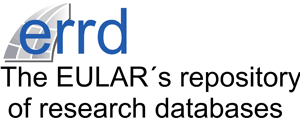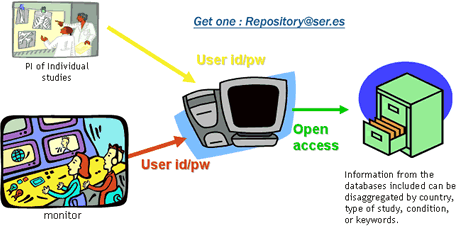Proyecto en el que la SER ha colaborado con EULAR. Actualmente, EULAR gestiona toda la información relacionada con este repositorio de base de datos.
an initiative of the Standing Committee of Epidemiology and Health Services Research (SCHER)
Why a database of databases
- There are probably hundreds of databases in the European rheumatology that are being used for research purposes.
- Many of these databases have overlapping objectives.
- Researchers are many times unaware of similar databases to theirs.
- The impression of duplicity of resources and lack of real collaboration between European rheumatologists is the main rationale for this repository of databases under the EULAR umbrella.
- In what ways is good to European rheumatologists
- Knowing what is being studied in Europe is a way to measure excellence and collaboration in research.
- Areas of excess or under research can be timely ascertained. It would therefore help to design research agendas.
- Many researchers would benefit from knowing that other groups may share an interest in a certain topic. This platform will help develop networks and collaborations by identification of potential collaborative projects.
- If databases share design, sampling and items in common, it may be very helpful to link databases and produce collaborative results for secondary objectives for which one single database is not powered enough.
- To know and to use old cohorts as historical cohorts, may help to compare practice changing or outcome.
- It will facilitate the comparison of data across countries.
- It is specially interesting for rare diseases, or even for diseases or problems not so rare but for which it is more difficult to get an adequate budget for research, such as lupus, or carpal tunnel syndrome, or temporary work disability, as compared to the budgets approved for rheumatoid arthritis projects.
What’s in this repository?
- The EULAR’s repository of research databases will hold information on minimum quality study databases. The quality will be warranted from including only:
- Studies with published data
- Databases of studies presented for evaluation to research grants and approved.
- The type of databases that the ERRD will be home to:
- Prospective longitudinal observational studies:
- Registries
- Cohorts
- Clinical databases
- Of importance for the rheumatologist. Any condition or health problem considered rheumatic by the WHO will be under the scope.
- Large databases, with a minimum size of 100 subjects.
- Regarding the time, previous or published and/or on-going studies.
- Those that will provide enough information to allow others to understand the objective and basic structure.
- The ERRD will not host clinical databases without objectives (i.e. not for epidemiological, drug monitoring, practice, etc..), retrospective databases, or datasets from cross-sectional or case-control studies.
- Prospective longitudinal observational studies:
- The information will be grouped into sections:
- Administrative data,
- Study methodology
- Funding
- List of publications and presentations
- Keywords
Who manages the data of individual studies?
- Principal investigators (PI) or responsible researchers of the individual databases, are the ones who will manage the data. They will check and update the information on their studies.
- Each individual providing data will be given a username and a password to update the data on her or his database.
- Investigators other than the PI can look at the information on the databases but never modify it.
- Those who are potentially interested in a database can contact with the responsible of the database as presented in the repository for further details.
- A monitor will:
- provide the usernames and passwords
- see and check the data entered
- contact the PIs to confirm data or to check inconsistencies
- The ERRD is coordinated by Dr Loreto Carmona, from the Research Unit of the Spanish Foundation of Rheumatology, member of the SCHER.
How to use ERRD?
This application allows the update of information on databases in real time. It can be consulted at any time.Information on the databases is only edited by the responsible of a database, although he or she may grant permission for editing to the monitor of the ERRD.
Now that you know, ENTER data into the repository
Now that you know, RETRIEVE data from the repository














